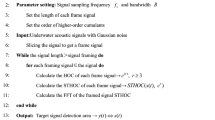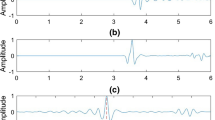Abstract
To address the problem that the traditional generalized cross-correlation (GCC) method has poor delay estimation accuracy in the low signal-to-noise ratio (SNR) environment or complex noise background, an adaptive time delay estimation algorithm based on signal preprocessing and fourth-order cumulant is proposed. We first preprocess the noisy signal using singular value decomposition and wavelet denoising. Next, we use an improved variable step-size least mean square algorithm based on multi-scale wavelet transform to iteratively operate on the one-dimensional slice of fourth-order cumulant. Finally, we derive the time delay from the peak offset of the filter weight coefficient. The simulation results show that the proposed method outperforms the GCC method and the fourth-order cumulant GCC method in Gaussian non-correlated noise, Gaussian correlated noise, and non-Gaussian noise backgrounds, achieving relatively accurate estimation results even in a low SNR environment. This technique could offer a new approach for detecting weak signals and passively locating small targets in ocean exploration.











Similar content being viewed by others
References
M. Azaria, D. Hertz, Time delay estimation by generalized cross correlation methods. IEEE Trans. Acoust. Speech Signal Process. 32(2), 280–285 (1984). https://doi.org/10.1109/TASSP.1984.1164314
T.P. Bhardwaj, R. Nath, Maximum likelihood estimation of time delays in multipath acoustic channel. Signal Process. 90(5), 1750–1754 (2010). https://doi.org/10.1016/j.sigpro.2009.11.023
V. Bruni, D. Vitulano, Wavelet-based signal de-noising via simple singularities approximation. Signal Process. 86(4), 859–876 (2006). https://doi.org/10.1016/j.sigpro.2005.06.017
M.V. Dokic, P.M. Clarkson, Real-time adaptive filters for time-delay estimation. Mech. Syst. Signal Process. 6(5), 403–418 (1992). https://doi.org/10.1016/0888-3270(92)90065-Q
D.L. Donoho, J.M. Johnstone, Ideal spatial adaptation by wavelet shrinkage. Biometrika 81(3), 425–455 (1994). https://doi.org/10.1093/biomet/81.3.425
R. Henry, J. Hofrichter, Singular value decomposition: application to analysis of experimental data. Methods Enzymol 210(2), 129–192 (1992). https://doi.org/10.1016/0076-6879(92)10010-B
K. Ho-Wuk, P. Hong-Sug, L. Sang-Kwon, Modified-filtered-u LMS algorithm for active noise control and its application to a short acoustic duct. Mech. Syst. Signal Process. 25(1), 475–784 (2011). https://doi.org/10.1016/j.ymssp.2010.09.001
C. Knapp, G. Carter, The generalized correlation method for estimation of time delay. IEEE Trans. Acoust. Speech Signal Process. 24(4), 320–327 (1976). https://doi.org/10.1109/TASSP.1976.1162830
Z.X. Li, W.X. Dai, Local mean decomposition combined with SVD and application in telemetry vibration signal processing. Appl. Mech. Mater. 347(2), 854–858 (2013). https://doi.org/10.4028/www.scientific.net/AMM.347-350.854
F. Liu, Y. Zhang, X. Yang, Parametric multipath time delay estimation based on fourth-order cumulants and singular value decomposition. Electron. Inform. Warfare Technol. 24(5), 16–19 (2009)
S. Mallat, W.L. Hwang, Singularity detection and processing with wavelets. IEEE Trans. Inform. Theory 38(2), 617–643 (1992). https://doi.org/10.1109/18.119727
J.M. Mendel, Tutorial on higher-order statistics (spectra) in signal processing and system theory: theoretical results and some applications. Proc. IEEE 79(3), 278–305 (1991). https://doi.org/10.1109/5.75086
M. Nasri, H. Nezamabadi, Image denoising in the wavelet domain using a new adaptive thresholding function. Neurocomputing 72(4), 1012–1025 (2009). https://doi.org/10.1016/j.neucom.2008.04.016
C.L. Nikias, J.M. Mendel, Signal processing with higher-order spectra. IEEE Signal Process. Mag. 10(3), 10–37 (1993). https://doi.org/10.1109/79.221324
C.L. Nikias, R. Pan, Time delay estimation in unknown Gaussian spatially correlated noise. IEEE Trans. Acoust. Speech Signal Process. 36(11), 1706–1714 (1988). https://doi.org/10.1109/29.9008
Z.W. Qian, L. Cheng, Y.H. Li, Noise reduction method based on singular value decomposition. J. Vib. Meas. Diagn. 31(4), 459–463 (2011). https://doi.org/10.16450/j.cnki.issn.1004-6801.2011.04.010
A. Rajwade, A. Rangarajan, A. Banerjee, Image denoising using the higher order singular value decomposition. IEEE Trans. Pattern Anal. Mach. Intell. 35(4), 849–862 (2013). https://doi.org/10.1109/TPAMI.2012.140
F. Reed, P. Feintuch, N. Bershad, Time delay estimation using the LMS adaptive filter–static behaviour. IEEE Trans. Acoust. Speech Signal Process. 29(3), 561–571 (1981). https://doi.org/10.1109/TASSP.1981.1163614
S. Sardy, P. Tseng, A. Bruce, Robust wavelet denoising. IEEE Trans. Signal Process. 49(6), 1146–1152 (2001). https://doi.org/10.1109/78.923297
C. Sun, L. Li, W. Chen, Quadratic correlation time delay estimation algorithm based on Kaiser window and Hilbert transform. in Proceedings of the IEEE International Conference on Instrumentation and Measurement, Computer, Communication and Control (IMCCC), Harbin, China, (2016), pp. 927–931. https://doi.org/10.1109/IMCCC.2016.149
R. Tao, X.M. Li, Y.L. Li et al., Time-delay estimation of chirp signals in the fractional Fourier domain. IEEE Trans. Signal Process. 57(7), 2852–2855 (2009). https://doi.org/10.1109/TSP.2009.2020028
F.Q. Tian, R. Luo, A novel variable step size LMS algorithm based on modified hyperbolic tangent and its simulation. Adv. Mater. Res. 490(6), 1426–1430 (2012). https://doi.org/10.4028/www.scientific.net/AMR.490-495.1426
J.K. Tugnait, Frequency domain adaptive filters using higher-order statistics with application to adaptive time delay estimation. Int. J. Adapt. Control Signal Process. 10(2), 137–157 (1996). https://doi.org/10.1002/(SICI)1099-1115(199603)10:2/3
Y. Wu, A. R. Leyman, Time delay estimation using higher-order statistics: a set of new results. in Proceedings of the IEEE International Conference on Information, Communications and Signal Processing (ICICS), Singapore, vol. 3 (1997), pp. 1397–1400. https://doi.org/10.1109/ICICS.1997.652220.
H.J. Wu, Y.M. Wen, P. Li, Dynamic discrimination of convergence of the LMS time delay estimation in complicated noisy environments. Appl. Acoust. 68(6), 628–641 (2007). https://doi.org/10.1016/j.apacoust.2006.03.011
Q. Zhang, L. Zhang, An improved delay algorithm based on generalized cross correlation. in Proceeding of the IEEE 3rd Information Technology and Mechatronics Engineering Conference (ITOEC), Chongqing, China, (2017), pp. 395–399. https://doi.org/10.1109/ITOEC.2017.8122323.
X.Z. Zhao, B.Y. Ye, T.J. Chen, Principle of singular signal detection based on SVD and its application. J. Vib. Shock 21(6), 11–14 (2008). https://doi.org/10.13465/j.carolcarrollnkiJVS.2008.06.040
Funding
This research was supported by funds from the National Natural Science Foundation of China under Grant Numbers 41906005, 41705081, National Key Research and Development Project of China under Grant Numbers 2017YFB0202701, and National Basic Research Program of China under Grant Number 2019-JCJQ-ZD-149-00.
Author information
Authors and Affiliations
Contributions
Conceptualization, BL and XZ; methodology, BL; software, BL; validation, SJ; formal analysis, SZ; data curation, DT; writing—original draft preparation, BL; writing—review and editing, BL; all authors have read and agreed to the published version of the manuscript.
Corresponding author
Ethics declarations
Conflicts of interest
The authors declare no conflict of interest.
Additional information
Publisher's Note
Springer Nature remains neutral with regard to jurisdictional claims in published maps and institutional affiliations.
Rights and permissions
Springer Nature or its licensor (e.g. a society or other partner) holds exclusive rights to this article under a publishing agreement with the author(s) or other rightsholder(s); author self-archiving of the accepted manuscript version of this article is solely governed by the terms of such publishing agreement and applicable law.
About this article
Cite this article
Liu, B., Zhang, X., Jia, S. et al. Adaptive Time Delay Estimation Based on Signal Preprocessing and Fourth-Order Cumulant. Circuits Syst Signal Process 42, 6160–6181 (2023). https://doi.org/10.1007/s00034-023-02390-7
Received:
Revised:
Accepted:
Published:
Issue Date:
DOI: https://doi.org/10.1007/s00034-023-02390-7




